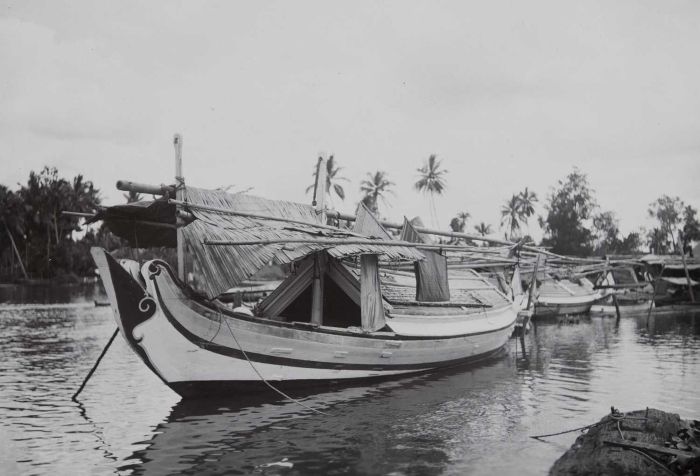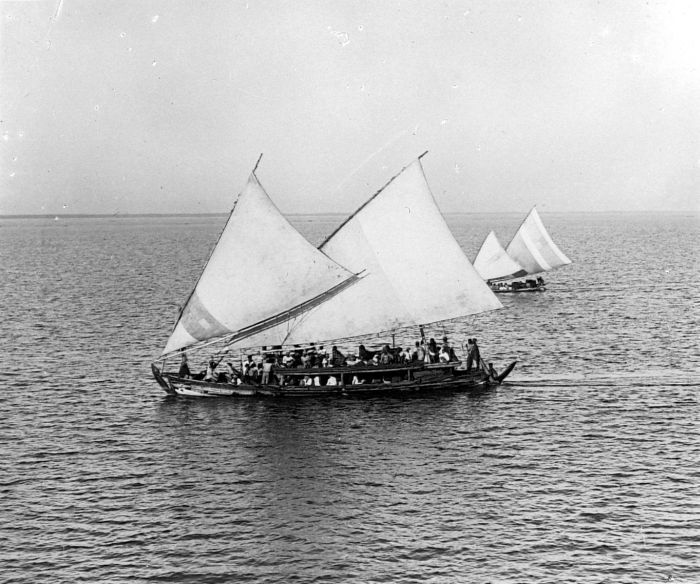Golekan on:
[Wikipedia]
[Google]
[Amazon]

 Golekan is a type of traditional boat from
Golekan is a type of traditional boat from
 The golekan is an indigenous ''
The golekan is an indigenous ''
 In the past, golekan is used as transport vessel, reaching as far as Singapore. In the early 1950s golekan from Sepulu were sailing to Singapore with mixed cargoes of palm sugar, coffee, tamarind, dried fish, and mats, along with considerable numbers of passengers from the island of Bawean. Madurese skippers would buy cattle from local market and sell them for handsome profit in
In the past, golekan is used as transport vessel, reaching as far as Singapore. In the early 1950s golekan from Sepulu were sailing to Singapore with mixed cargoes of palm sugar, coffee, tamarind, dried fish, and mats, along with considerable numbers of passengers from the island of Bawean. Madurese skippers would buy cattle from local market and sell them for handsome profit in

 Golekan is a type of traditional boat from
Golekan is a type of traditional boat from Madura
Madura Island is an Indonesian island off the northeastern coast of Java. The island comprises an area of approximately (administratively 5,379.33 km2 including various smaller islands to the east, southeast and north that are administrati ...
, Indonesia
Indonesia, officially the Republic of Indonesia, is a country in Southeast Asia and Oceania between the Indian and Pacific oceans. It consists of over 17,000 islands, including Sumatra, Java, Sulawesi, and parts of Borneo and New Guine ...
. They once plied as far as Singapore
Singapore (), officially the Republic of Singapore, is a sovereign island country and city-state in maritime Southeast Asia. It lies about one degree of latitude () north of the equator, off the southern tip of the Malay Peninsula, borde ...
, where they are referred to as Madurese traders. In the present this type of boat is only known locally, especially near Bangkalan
Bangkalan is a town on the western coast of Madura Island in Indonesia, the government seat of the Bangkalan Regency.
Tourism
Mount Jaddih is 10 kilometres from Bangkalan and can be accessed by a motorcycle to the mountain top to see Bangkalan ...
in Western Madura and around the Kangean islands
The Kangean Islands or simply Kangean (Indonesian language, Indonesian: ''Kepulauan Kangean'') is a collective name referred to the area of Kangean Island, Kangean (the main island) and its surrounding islands lie in the north of Bali Isla ...
.Horridge (2015). p. 79.
Etymology
Dutch observer van Deventer wrote that it means "freight seeker". Gibson-Hill stated the name comes fromMalay
Malay may refer to:
Languages
* Malay language or Bahasa Melayu, a major Austronesian language spoken in Indonesia, Malaysia, Brunei and Singapore
** History of the Malay language, the Malay language from the 4th to the 14th century
** Indonesi ...
word ''golek'', which he claimed meant crank (tender, or 'tippy') when applied to a canoe. Rather, the name derived from ''kolek'', a Javanese word for 'boat', applied to a wide range of small craft along the north coast of Java. Thus the name ''golekan'' would meant 'a kind of ''kolek''Description
 The golekan is an indigenous ''
The golekan is an indigenous ''perahu
Proas are various types of multi-hull outrigger sailboats of the Austronesian peoples. The terms were used for native Austronesian ships in European records during the Colonial era indiscriminately, and thus can confusingly refer to the do ...
'' type, with no trace of modern influence in hull form, construction, or sailing rig. Despite the traditional nature of design, golekan appears to have been a relatively recent development.Stenross (2007). p. 85. Golekan had single large and fat ''linggi'' (stempost) just like leti leti
Leti leti is a type of traditional transport vessel from East Madura, Indonesia, especially from the administrative district of Sumenep. The leti leti is a recent development, the hull form and sail were developed in the 19th century. In 1979 sail ...
, with ''gulungan'' motifs painted black. It has deckhouse without secondary cabin at the aft of the boat. Usually had 2 sails (usually lete sail), with upper beam supported by temporary pole and mast at the direction of the wind, or at both side of the boat, with support ropes at both upper beam. The hulls were always painted white, with polychrome sheer stripe, and the upper portions of end posts, as well as the finials painted black. Medium-sized golekan used as fish transporters were about 12 metres in length with a long deckhouse. The golekan of Telaga Biru were both larger and more numerous than elsewhere, consistent in size at about 55 feet (16.8 m) length and 14 feet (4.3 m) beam. The vessels remained fully traditional until mid-1970s, when the first engine was installed. The last traditional golekan was built in 1983. Golekans reaching Singapore in 1950s has a length of 50–55 ft (15.24–16.8 m) with 12.5–13 ft (3.81–3.96 m) beam, waterline length of 41–45 ft (12.5–13.7 m). A golekan with 52 ft (15.85 m) waterline could carry 500–550 ''pikul'' (31.2–34.4 ton). They are slow, seldom exceed 8.5 knots (15.7 km/h).
Role
 In the past, golekan is used as transport vessel, reaching as far as Singapore. In the early 1950s golekan from Sepulu were sailing to Singapore with mixed cargoes of palm sugar, coffee, tamarind, dried fish, and mats, along with considerable numbers of passengers from the island of Bawean. Madurese skippers would buy cattle from local market and sell them for handsome profit in
In the past, golekan is used as transport vessel, reaching as far as Singapore. In the early 1950s golekan from Sepulu were sailing to Singapore with mixed cargoes of palm sugar, coffee, tamarind, dried fish, and mats, along with considerable numbers of passengers from the island of Bawean. Madurese skippers would buy cattle from local market and sell them for handsome profit in Pontianak
Pontianak or Khuntien is the capital of the Indonesian province of West Kalimantan, founded first as a trading port on the island of Borneo, occupying an area of 118.31 km2 in the delta of the Kapuas River at a point where it is joined by ...
, Manggar
Manggar () is a town in the Indonesian province of Bangka-Belitung, Indonesia which is a port on the east coast of Belitung Island, and is the seat of the East Belitung Regency. The town was founded as a tin mining town in the 19th century.
Histo ...
, or Pangkal Pinang
Pangkal Pinang is the capital and largest city of the Bangka Belitung Islands Province in Indonesia. It is located on Bangka Island's east coast, the city is divided into seven districts (''kecamatan'') and has 42 wards (''kelurahan'').
It cov ...
. The vessels would make 6 voyages a year, during dry season only. Largest golekan could carry up to 40 animals, tethered on a platform inside the long deckhouse. Large amounts of fodder and water needed to be carried to nourish them for the voyage. Since 1980s increasing amount of timber were brought to Telaga Biru. in 1990s this timber trade bloomed, trucks from East Java and even Bali regularly making their way to Telaga Biru to obtain the high-quality timber being landed there.
The main role for small golekan (about 20 tons in weight) is for transporting fishes from perahu mayang that remains at the sea. They had a row of boiling pots for sterilizing fishes just like lis-alis
Lis-alis is a type of traditional boat of Madura, Indonesia. Lis-alis usually present in canals that provide salt evaporation service in southern part of Madura and around Surabaya. Until the present, lis-alis remained overwhelmingly popular as a ...
. In Bangkalan, the reason why they had 2 different type of boat is that the golekan is heavier and slower than lis-alis but they are more useful in open sea compared to lis-alis. Golekan is associated with man while lis-alis is associated with woman, and every village must have several from each kind to survive in every season, golekan is the one used when western season wind arrived.Horridge (2015). p. 80.
See also
Other Madurese boats: *Lis-alis
Lis-alis is a type of traditional boat of Madura, Indonesia. Lis-alis usually present in canals that provide salt evaporation service in southern part of Madura and around Surabaya. Until the present, lis-alis remained overwhelmingly popular as a ...
*Janggolan
Janggolan refers to two different type of ''perahu'' from Indonesia. One is from Madura, and the other from Bali. The Madurese janggolan is a type of indigenously constructed boat, meanwhile Balinese janggolan is an indigenous boat with western-sty ...
* Leti-leti
Other perahu from Nusantara:
* Lambo
*Mayang (boat)
Perahu Mayang or simply mayang is a type of fishing boat from Java, Indonesia. This type of boat is used mainly for fishing and trading. Historically, this indigenous vessel is also favored by European skippers and private merchants for trading in ...
*Patorani
Patorani (also prauw patorani or perahu patorani) is a traditional fishing boat from Makassar, Indonesia. It is used by Macassan people for fishing, transport, and trading since at least 17th century A.D. Historically this type of boat was used by ...
References
Further reading
* Horridge, Adrian (2015). ''Perahu Layar Tradisional Nusantara''. Yogyakarta: Penerbit Ombak. An Indonesian translation of Horridge, Adrian (1985). ''The Prahu: Traditional Sailing Boat of Indonesia, second edition''. Oxford: Oxford University Press. * Stenross, Kurt (2007). ''The Seafarers and Maritime Entrepreneurs of Madura: History, Culture, and Their Role in the Java Sea Timber Trade''. Murdoch University, Perth, Australia. {{Indonesian traditional vessels Sailboat types Indonesian inventions Types of fishing vessels Boats of Indonesia Tall ships